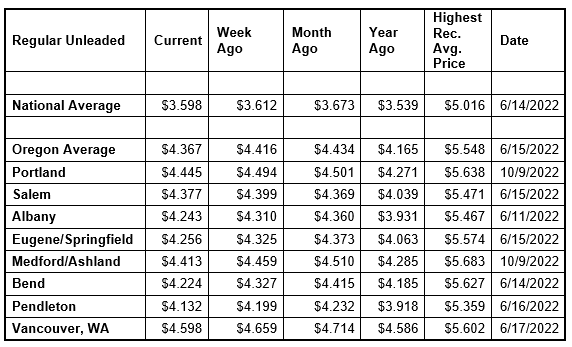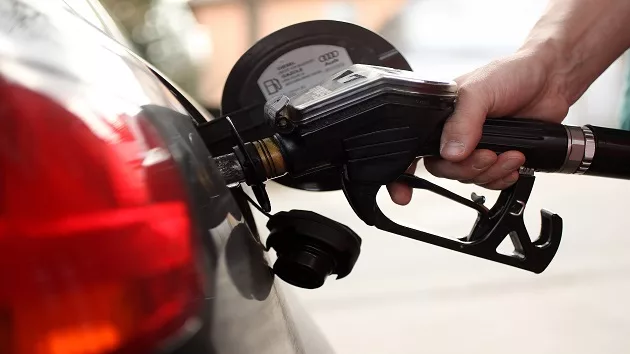The national and Oregon averages for a gallon of gas continue their pokey declines. Weak demand for gas in the U.S. and crude prices below $80 per barrel are the primary drivers. For the week, the national average for regular slips one cent to $3.60. The Oregon average loses five cents to $4.37 a gallon. This is the sixth-largest week-over-week drop for a state in the nation.

“Pump prices should continue their glacial descent through the long Memorial Day weekend, barring unforeseen events. That’s good news for drivers who’ll be taking a holiday road trip,” says Marie Dodds, public affairs director for AAA Oregon/Idaho. “Still, there are potential wild cards that could send pump prices higher this summer, including crude oil prices, major storms or hurricanes, or other disruptions in supplies.”
AAA says Memorial Day travel will be the second busiest on record. AAA projects 43.8 million Americans million people (13% of the population) will travel 50 miles or more from home this Memorial Day weekend. This is an increase of 4% over 2023 and just shy of matching the record of 44 million travelers in 2005.
About 600,000 Oregonians will travel over the long weekend.
Find all the details, graphics, top destinations, best and worst times to drive, and advice for travelers in the AAA Memorial Day travel news release.
The national and Oregon averages are at the same prices as they were in early April.
The Oregon average began 2024 at $3.79 a gallon compared to $4.37 today. Its lowest price so far this year is $3.58 on February 14 and the highest is nearly $4.51 on May 1. The national average started the year at $3.11 and is at $3.60 today. Its lowest price so far this year is just under $3.07 on January 15 and the highest is just under $3.68 on April 19.
Gas prices always rise starting in late winter through the spring as refineries undergo maintenance as the switch to summer-blend fuel occurs. The switch occurs first in California, which is why pump prices on the West Coast often rise before other parts of the country. The East Coast is the last major market to make the change to summer-blend fuel. Most areas have a May 1 compliance date for refiners and terminals, while most gas stations have a June 1 deadline to switch to selling summer-blend until June 1. Switch-over dates are earlier in California with some areas in the state requiring summer-blend fuel by April 1. Some refineries will begin maintenance and the switchover as early as February.
Crude oil prices have remained elevated and volatile due to geopolitical events around the world including increased volatility in the Middle East, the war between Russia and Ukraine, and Houthi militant attacks in the Red Sea. In addition, production cuts by OPEC+ have tightened global crude oil supplies.
The price of crude oil reached the year-to-date high of nearly $87 per barrel on April 5 and has moved lower since then. West Texas Intermediate climbed above $80 on March 14 and above $85 on April 2, then dipped below $85 starting on April 17 and below $80 again on May 1. Major drivers of elevated crude prices are the unrest in the Middle East and the Ukrainian attacks on Russian refineries. Russia is a top global oil producer and the refinery attacks have reduced output.
Crude prices have been volatile after the attack on Israel by Hamas in October. While Israel and the Palestinian territory are not oil producers, concerns remain that the conflict could spread in the Middle East, which could potentially impact crude production in other oil-producing nations in the region.
Crude oil is trading around $78 today compared to $78 a week ago and $72 a year ago. In 2023, West Texas Intermediate ranged between $63 and $95 per barrel. Crude reached recent highs of $123.70 on March 8, 2022, shortly after the Russian invasion of Ukraine, and $122.11 per barrel on June 8, 2022. The all-time high for WTI crude oil is $147.27 in July 2008.
Crude oil is the main ingredient in gasoline and diesel, so pump prices are impacted by crude prices on the global markets. On average, about 56% of what we pay for in a gallon of gasoline is for the price of crude oil, 19% is refining, 10% distribution and marketing, and 15% are taxes, according to the U.S. Energy Information Administration.
Demand for gasoline in the U.S. remains lackluster but is expected to climb over the Memorial Day holiday weekend. Demand for gas in the U.S. rose modestly from 8.79 to 8.87 million b/d for the week ending May 10, according to the U.S. Energy Information Administration (EIA). This compares to 8.91 million b/d a year ago. Meanwhile, total domestic gasoline stocks decreased slightly from 228 to 227.8 million bbl.
Tepid pre-Memorial Day demand and steady or falling oil prices could lower pump prices.
Quick stats
Oregon is one of 39 states and the District of Columbia with lower prices now than a week ago. Colorado (+13 cents) has the biggest weekly increase. Utah (-9 cents) has the largest week-over-week decline in the nation.
California ($5.19) has the most expensive gas in the nation for the 12th week in a row and remains the only state in the nation with an average at or above $5 per gallon. Hawaii ($4.80) is second, Washington ($4.60) is third, Oregon ($4.37) is fourth, Nevada ($4.36) is fifth, and Alaska ($4.33) is sixth. These are the six states with averages at or above $4 a gallon, same as a week ago. This week 44 states and the District of Columbia have averages in the $3-range. No states have averages in the $2 range this week.
The cheapest gas in the nation is in Mississippi ($3.06) and Oklahoma ($3.09) and. No state has had an average below $2 a gallon since January 7, 2021, when Mississippi and Texas were below that threshold.
The difference between the most expensive and least expensive states is $2.13 this week, compared to $2.20 a week ago.
Oregon is one of 44 states and the District of Columbia with lower prices now than a month ago. The national average is eight cents less and the Oregon average is seven cents less than a month ago. Nevada (-26 cents) has the largest monthly drop. Colorado (+16 cents) has the biggest monthly jump.
Oregon is one of 32 states and the District of Columbia with higher prices now than a year ago. The national average is six cents more than a year ago and the Oregon average is 20 cents more than a year ago. This is the third-largest yearly gain in the nation. Arizona (-73 cents) has the largest yearly decrease. Alaska (+40 cents) has the largest year-over-year increase.






